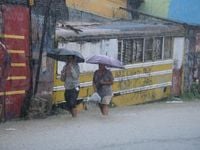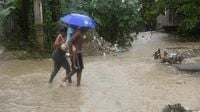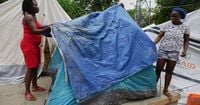Tropical Storm Melissa, a slow-moving but rapidly strengthening weather system, is battering the northern Caribbean with torrential rain, flooding, and the threat of deadly landslides. As of Saturday, October 25, 2025, the United States National Hurricane Center (NHC) reported that Melissa was on the verge of becoming a hurricane, with forecasts predicting it would escalate into a major hurricane by Sunday. Residents across Jamaica, Haiti, and the Dominican Republic are bracing for what could be a catastrophic event, with authorities warning of the potential for historic rainfall and widespread devastation.
The NHC’s latest update painted a grim picture for the region. Melissa, crawling across the central Caribbean Sea at a sluggish pace of 5 kilometers per hour, was packing maximum sustained winds of 110 kilometers per hour (70 mph). This slow movement, according to the NHC, means that affected areas could experience hurricane conditions for more than 72 hours—a prolonged assault that dramatically increases the risk of flooding and infrastructure collapse.
Rainfall projections are staggering. Up to 64 centimeters (25 inches) of rain is expected to drench Jamaica and the southern regions of Haiti and the Dominican Republic through Monday. For Haiti’s Tiburon Peninsula, the forecast is even more dire: as much as 89 centimeters (35 inches) of rain could fall in the coming days. "If those rains were to occur, you’re talking about catastrophic flooding potential," warned Jamie Rhome, the NHC’s deputy director, as cited by the Associated Press and other outlets. The risk of flash floods and landslides looms large, especially in mountainous and already-vulnerable communities.
Tragically, the storm has already claimed lives. Haitian authorities reported that three people have died—two in a landslide in Port-au-Prince and one struck by a falling tree in Marigot. Five others were injured when a wall collapsed amid the deluge. In the Dominican Republic, a fourth person has died and another remains missing as of Saturday. The storm’s impact has been felt in property damage as well: nearly 200 homes in the Dominican Republic have been destroyed, and more than half a million people are without access to clean water. Floodwaters have left over two dozen communities isolated, prompting mandatory evacuations and the closure of schools nationwide.
The situation is especially precarious for thousands in Haiti’s capital, Port-au-Prince, who have already been displaced by gang violence and now find themselves living in makeshift shelters with little protection from the elements. "I’m dealing with two storms: the gangs and the weather," said Nephtali Johnson Pierre in an interview with the Associated Press. The compounding crises highlight the vulnerability of populations living on the margins, where even a single disaster can quickly spiral into a humanitarian emergency.
Jamaica, directly in Melissa’s projected path, is taking extensive precautions. The Meteorological Service’s principal director, Evan Thompson, told The Gleaner that residents should brace for a "double effect" as the storm’s eye passes over the island, with the strongest winds battering from opposite directions. Prime Minister Andrew Holness issued a stern warning: "I urge Jamaicans to take this weather threat seriously. Take all measures to protect yourself." Authorities have prepared more than 650 emergency shelters across the island and announced that airports will close once a hurricane warning is declared. Warehouses are stocked and thousands of food packages have been positioned for rapid distribution if needed.
The storm’s reach extends beyond the immediate disaster zone. The Bahamas Department of Meteorology has warned that Melissa could bring tropical storm or hurricane conditions to the Southeast and Central Bahamas, as well as the Turks and Caicos Islands, by early next week. Eastern Cuba is also in the crosshairs; forecasts predict the storm will strike as a major hurricane by Wednesday, potentially dumping up to 30 centimeters (12 inches) of rain in some areas.
Amid the chaos, the region is grappling with the broader context of an unusually active hurricane season. Melissa is the 13th named storm of the 2025 Atlantic hurricane season, which runs from June 1 to November 30. The U.S. National Oceanic and Atmospheric Administration (NOAA) had predicted an above-normal season, anticipating between 13 and 18 named storms. According to NOAA and climate scientists, the increasing intensity and frequency of such storms are linked to a warming atmosphere, driven largely by human fossil-fuel use. As the climate changes, extreme weather events like Melissa are expected to become more common and more destructive.
For many in the Caribbean, the science behind these trends is less immediate than the day-to-day reality of survival. In the Dominican Republic, families in neighborhoods like Los Rios were forced to flee their homes as rivers burst their banks, while in Haiti, rising river levels and breached riverbanks destroyed bridges in places like Sainte-Suzanne. The slow pace of the storm, while giving some time to prepare, also means the misery is drawn out—roads remain impassable, emergency crews struggle to reach isolated communities, and the threat of further landslides or building collapses persists with every hour of rain.
Emergency response efforts are in full swing across the region. In Jamaica, authorities have activated shelters and pre-positioned food supplies. In the Dominican Republic, evacuations are underway and efforts are being made to restore water and electricity to the hardest-hit areas. In Haiti, aid organizations are working to support those displaced by both violence and the storm, though access remains a significant challenge due to insecurity and damaged infrastructure.
As the weekend progresses, all eyes are on Melissa’s path and the potential for further escalation. Forecasters warn that the storm could reach Category 4 status by early Monday, bringing even stronger winds and heavier rains. Southeast Cuba, the Bahamas, and the Turks and Caicos Islands are all bracing for impact, with officials urging residents to heed warnings and make necessary preparations.
The unfolding crisis serves as a sobering reminder of the vulnerability of Caribbean nations to natural disasters and the urgent need for resilience in the face of an increasingly volatile climate. For those on the ground, the coming days will be a test of preparedness, endurance, and community solidarity as they weather yet another storm.



